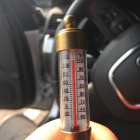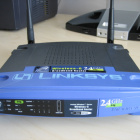Keith Neufeld
Member Since: May 11, 2006
Country: United States
-
This looks like the Artemis is included in the BlackBoard, but I don't see that specifically called out in the description and at a shockingly low $20 for the board, it's worth confirming!
-
Older cars with physical climate-control levers that pull cables to move flaps tended to have a vent setting that left intake open from somewhere to the cabin vents. I've often wondered how much cooling could be accomplished via convection by leaving the sunroof open and the climate control on the vent setting; and then how much more would be added with sunroof exhaust fans.
I agree with all the other commenters that intake will be crucial.
-
Leaving home-network credentials written down on paper at home is really not a horrible security idea.
Risk = likelihood * consequence. The likelihood of someone breaking into your house and exploiting your written-down credentials is quite low and the consequence if they do isn't that severe.
That's a different equation than the likelihood and consequence of someone exploiting written-down credentials at the office. And I still wouldn't leave banking credentials written down at home. The likelihood of a burglar finding them is low but the consequence is significantly higher than exploitation of IoT credentials.
-
Rob, I'd offer an alternate perspective on the profusion of development boards -- dilution of developer attention.
Perl and Arduino both became wildly successful not because of technical superiority (and I'm actually a fan of the design of both of them) but because of the vast amounts of library and sample code developed and shared for each of those platforms.
Granted, more folks are playing with microcontrollers and development systems today than ever before, so it's a bigger game. But the greater the number of development boards on the market, the fewer will have large communities surrounding them and the fewer will have large repositories to reduce the barrier to entry.
Just another perspective.
-
Thanks for the quick replies! <3 SparkFun :-)
-
That's "they're cool blue" or "it's cool that they'll work?" :-)
-
Can you tell me, are these LEDs warm white or cool white? I'm looking for cool white and these look to be perfect for the project if that's what they are.
-
No, 0.08" diameter is implausibly small. I think the holes must be based on the Dimension layer (20) rather than the Holes layer (45), which makes them about 0.065" radius, or about the right size for a #5 machine screw.
-
Could you tell me the diameter (or radius) of the standoff/mounting holes in the four corners? I can see in the EAGLE board file that they're positioned at X = 0.10" and 3.60" and Y = 0.10" and 1.85"; and it looks like their radius is 0.04"; but it'd be nice to confirm that before laser-cutting my own chassis (because I think I'd rather use different wheels than those that come with the Magician chassis).
-
As others have noted, something that can be done with a rigid board is not a cool flexible circuit design. And I understand the reluctance to use this for an application that must bend in use when you don't yet have experience with the way it holds up to repeated flexing, leading to Pete's suggestion that the right design will use the flex during installation but remain stationary once installed.
One thing that comes to mind is flex versions of SMT breakout boards with the breakout at the head end, several choices of strip lengths, and the corresponding socket for the tail end. Assuming the White Flex Circuits support vias, the flex strips could be double-sided and extremely narrow. This would allow a great deal of leeway in physically routing (low-frequency) signals from e.g. SMT sensor ICs back to control boards in customer projects, something that's clumsier today using breakout boards and fly wires and bulkier using breakout boards and ribbon cables.
No public wish lists :(






